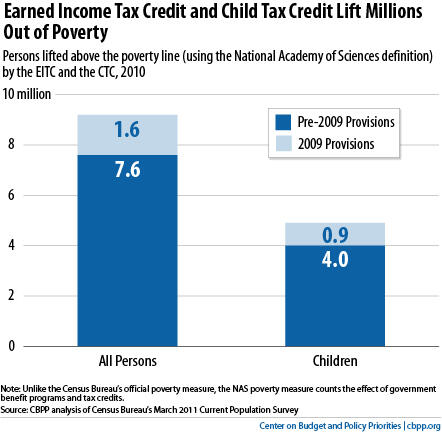off the charts
POLICY INSIGHT
BEYOND THE NUMBERS
BEYOND THE NUMBERS
A House Ways and Means subcommittee will hold a hearing tomorrow on how the structure of safety-net programs like the Earned Income Tax Credit (EITC) affects recipients’ work incentives.
As our new report explains, numerous studies have found that the EITC not only encourages work but also reduces poverty, helps families meet basic needs, and improves children’s achievement in school and likely increases their earnings as adults. The Child Tax Credit (CTC), a related tax credit designed to help offset the cost of raising children, also plays a pivotal role in helping low-income families.
For example:
- Encouraging work. Numerous studies have found that the EITC promotes work. “[T]he overwhelming finding of the empirical literature is that EITC has been especially successful at encouraging the employment of single parents, especially mothers,” write economists Nada Eissa of Georgetown University and Hilary Hoynes of the University of California, Davis. In fact, while policymakers often point to the 1996 welfare law’s creation of Temporary Assistance for Needy Families (TANF) as the primary reason for increased work among single mothers, the research indicates that expansion of the EITC had a larger effect than the welfare law in producing these gains.
- Reducing poverty. The EITC and CTC lifted 9.2 million people — including 4.9 million children — above the poverty line in 2010, under a broad measure of poverty that counts refundable tax credit payments as income (and subtracts income and payroll taxes). (See graph.) Improvements in these credits enacted as part of the 2009 Recovery Act are responsible for lifting 1.6 million of those people above the poverty line.Image

- Providing a short-term safety net. Most EITC recipients claim the credit only temporarily when a job disruption or other significant event reduces their income. A recent study found that, of people who received the EITC over an 18-year period, 61 percent received the credit for only one or two years at a time. A forthcoming study finds that over time, EITC recipients as a whole pay far more in federal income taxes than they receive in EITC benefits.
- Improving children’s school performance and increasing their work effort and earnings as adults. A small but growing body of research indicates that lifting the incomes of low-income families helps children in those families do better in school. The added income may help children later in life, as well: recent research finds that raising a poor family’s income by $3,000 a year (a fairly typical amount for a poor family to receive from the CTC and EITC) between a child’s prenatal year and fifth birthday is associated with a significant increase in the child’s earnings in adulthood. The leading study finds a 17 percent increase in earnings in adulthood, and an average of 135 hours of additional work per year, compared to similar children whose families do not receive the increase in income.
Click here for the full report.
Stay up to date
Receive the latest news and reports from the Center
